Vampires are fascinating in that they operate on the fringe of a culture and society. In some ways, they represent the ultimate outcast, often othered for their monsterness, and because of it, they needn’t adhere to what’s traditional or considered socially acceptable. In some instances, they’re almost auto-excluded from social norms and normative relationships. It seems bad on the surface but there’s a kind of enviable freedom that comes with being a blood sucking monster that deviates from the norm. Consider traditional female aspects such as neatness, quietness, politeness, being virginal, and so forth. Rayne from the BloodRayne series and Eli from the Swedish film Let the Right One In serve as strong examples of unconventional femaleness because they challenge traditional femaleness. They are not silent, virginal, or apologetic for who or what they are.
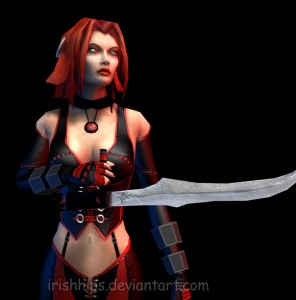 Rayne from BloodRayne is a sexy, half vampire woman who works as an assassin for a secret organization called the Brimstone Society. The games are a traditional hack and slash. Though Rayne manages to present as empowered on some levels, she does adhere to the sexy vampire trope at first glance. It’s hard to dismiss whether or not she’s the product of traditionally male developers and the design for the male gaze: scantily clad and busty, she’s presented as something akin to a fetish fantasy. However, this is more of a speculation than anything. Rayne’s choices are never explored, so we don’t know if this is an outgrowth of designers thinking about traditional vampires or those anarchistic others outside society. Players are left to wonder about Rayne’s decisions but I assume that she selects her own articles of clothing, which is acceptable so long as it’s her choice. Her leather outfit suits her fiery personality and attitude. In shifting perspective, one might argue that it’s impossible to separate the building of the game and the game’s developers. If the team is largely men, is she really an empowered female figure? Rayne’s form fitting outfit may very well dwindle down to a design preference or choice. It’s hard to say because the series allows for a number of various interpretations.
Rayne from BloodRayne is a sexy, half vampire woman who works as an assassin for a secret organization called the Brimstone Society. The games are a traditional hack and slash. Though Rayne manages to present as empowered on some levels, she does adhere to the sexy vampire trope at first glance. It’s hard to dismiss whether or not she’s the product of traditionally male developers and the design for the male gaze: scantily clad and busty, she’s presented as something akin to a fetish fantasy. However, this is more of a speculation than anything. Rayne’s choices are never explored, so we don’t know if this is an outgrowth of designers thinking about traditional vampires or those anarchistic others outside society. Players are left to wonder about Rayne’s decisions but I assume that she selects her own articles of clothing, which is acceptable so long as it’s her choice. Her leather outfit suits her fiery personality and attitude. In shifting perspective, one might argue that it’s impossible to separate the building of the game and the game’s developers. If the team is largely men, is she really an empowered female figure? Rayne’s form fitting outfit may very well dwindle down to a design preference or choice. It’s hard to say because the series allows for a number of various interpretations.
I often question where the line of sexy bitch for the male gaze stops and the empowered sexual female begins. It’s a blurry line. When she sucks blood, an attack that replenishes her health meter, she wraps her legs around the typically male enemy and releases audible moans of pleasure. Rayne could very well be relishing in her own pleasure and overt sexuality. Her femaleness is unconventional in that it’s very apparent and unapologetic. She revels in it. It strays from the more traditional ideas about femaleness, such as restrictions on female sexuality and associations with the domestic. It’s hard for me to see Rayne censoring herself or sweeping the floors.
Rayne is generally unapologetic for her actions, which is a terrifically empowering thing to witness. In fact, the entire series is unapologetic and that’s one of the reasons why I personally enjoyed it. They’re overly bloody, violent, and sexual. There’s one instance at the end of the first game, after beheading one of the main antagonists, Rayne flips off his disembodied head with zero shame. She isn’t coquettish or demure. The redheaded vampire doesn’t encompass traditional feminine values, which is something I deeply appreciate and see as progressive. Her personality might be viewed as crass and therefore associated with maleness. However, it makes me wonder whether she’s only able to have those unconventional “masculine” traits because she’s a “bad” girl.
 What is bad, really? What is evil? Why does badness or evilness equate to maleness? Why can’t a woman break the rules or behave without restrictions and still be considered female? I read a compelling article from Bitch Flicks that focuses on Eli (Let the Right One In) and Claudia (Interview with a Vampire), both of which are vampire children. When Claudia is first turned into a vampire, she’s celebrated and worshipped for her sweet innocence and neatness. Those traits can be viewed as traditionally feminine. Lestat, one of her makers, even commends her for not spilling a drop of blood after her first feeding as a newborn vampire. However, as Claudia grows older in mind and not in body, she rebels against her makers and attempts to claim her identity. She misbehaves and leaves her sweeter, more feminine traits at the metaphorical door. Lestat is no longer infatuated with her. He berates her and calls her naughty for disobeying. Lestat’s disapproval in Claudia links back to the idea of good femaleness versus bad femaleness. Good femaleness is associated with Claudia’s former traits such as neatness, coquettish innocence, passiveness, and so on. However, now that she’s “grown” and seeing the world for what it is, her bad femaleness comes into play when she questions her fathers and rebels against them.
What is bad, really? What is evil? Why does badness or evilness equate to maleness? Why can’t a woman break the rules or behave without restrictions and still be considered female? I read a compelling article from Bitch Flicks that focuses on Eli (Let the Right One In) and Claudia (Interview with a Vampire), both of which are vampire children. When Claudia is first turned into a vampire, she’s celebrated and worshipped for her sweet innocence and neatness. Those traits can be viewed as traditionally feminine. Lestat, one of her makers, even commends her for not spilling a drop of blood after her first feeding as a newborn vampire. However, as Claudia grows older in mind and not in body, she rebels against her makers and attempts to claim her identity. She misbehaves and leaves her sweeter, more feminine traits at the metaphorical door. Lestat is no longer infatuated with her. He berates her and calls her naughty for disobeying. Lestat’s disapproval in Claudia links back to the idea of good femaleness versus bad femaleness. Good femaleness is associated with Claudia’s former traits such as neatness, coquettish innocence, passiveness, and so on. However, now that she’s “grown” and seeing the world for what it is, her bad femaleness comes into play when she questions her fathers and rebels against them.
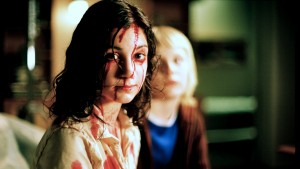 Eli (Let the Right One In) is a child vampire that moves into the apartment next to Oskar, a severely bullied 12 year old boy. Eli is comparable to Rayne in that she’s unapologetic for who she is and what she stands for. She advises Oskar, her feminine looking companion, to stand up to his bullies by hitting back harder than he dares. It’s an incredibly empowering and satisfying instance. She doesn’t conform to the traditional idea that girls are weak and scared. Eli’s both strong willed and independent. Her sex doesn’t define or restrict her. Claudia’s different in that has to depend on her makers for their physical strength from time to time. When she attempts to kill Lestat, she has to first disable him using nothing but her wits. She’s clever but her child body has its limitations. Eli’s the opposite in that she’s physically strong and able. She can take down a grown man by herself. There’s an incredibly disturbing scene in which Eli attacks an adult male under a bridge. She lures him in by crying for help, a technique that Claudia utilizes on an adult woman. When he picks her up and cradles her like a newborn babe, it might be seen as playing with the idea of traditional femaleness. She’s asking for male protection even though she doesn’t really need it or want it. When she turns on him, I’m startled by her quickness and ferocity. Her attack is similar to Rayne’s in that she manages to wrap herself around him and suck his blood. She gets him in an inescapable vice, her arms like bars of steel. Instead of losing herself in her blood lust and taking pleasure in it, she presses her head to her victim’s chest after she finishes and cries. It’s hard to pin down the root of her sadness. Is she sad for her victim? Is she repulsed by her own monstrosity? She doesn’t apologize outright but there’s some form of guilt weighing on her. Rayne takes great delight in her blood pleasures whereas Eli does not. It’s more of a requirement to live.
Eli (Let the Right One In) is a child vampire that moves into the apartment next to Oskar, a severely bullied 12 year old boy. Eli is comparable to Rayne in that she’s unapologetic for who she is and what she stands for. She advises Oskar, her feminine looking companion, to stand up to his bullies by hitting back harder than he dares. It’s an incredibly empowering and satisfying instance. She doesn’t conform to the traditional idea that girls are weak and scared. Eli’s both strong willed and independent. Her sex doesn’t define or restrict her. Claudia’s different in that has to depend on her makers for their physical strength from time to time. When she attempts to kill Lestat, she has to first disable him using nothing but her wits. She’s clever but her child body has its limitations. Eli’s the opposite in that she’s physically strong and able. She can take down a grown man by herself. There’s an incredibly disturbing scene in which Eli attacks an adult male under a bridge. She lures him in by crying for help, a technique that Claudia utilizes on an adult woman. When he picks her up and cradles her like a newborn babe, it might be seen as playing with the idea of traditional femaleness. She’s asking for male protection even though she doesn’t really need it or want it. When she turns on him, I’m startled by her quickness and ferocity. Her attack is similar to Rayne’s in that she manages to wrap herself around him and suck his blood. She gets him in an inescapable vice, her arms like bars of steel. Instead of losing herself in her blood lust and taking pleasure in it, she presses her head to her victim’s chest after she finishes and cries. It’s hard to pin down the root of her sadness. Is she sad for her victim? Is she repulsed by her own monstrosity? She doesn’t apologize outright but there’s some form of guilt weighing on her. Rayne takes great delight in her blood pleasures whereas Eli does not. It’s more of a requirement to live.
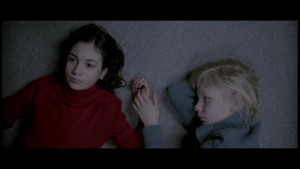 Eli’s not just a traditional female, or even a traditional female vampire, though the film only touches briefly on the subject of her sex. In one telling scene, Oksar takes a peek at Eli while she’s changing and sees her scarred genitalia. It’s a very brief glimpse but a glimpse nonetheless. In the novel it’s revealed that she’s the product of a twisted individual. The movie doesn’t offer much of an explanation for this scene but the book goes into Eli’s past and the fact that she’s actually a castrated boy.
Eli’s not just a traditional female, or even a traditional female vampire, though the film only touches briefly on the subject of her sex. In one telling scene, Oksar takes a peek at Eli while she’s changing and sees her scarred genitalia. It’s a very brief glimpse but a glimpse nonetheless. In the novel it’s revealed that she’s the product of a twisted individual. The movie doesn’t offer much of an explanation for this scene but the book goes into Eli’s past and the fact that she’s actually a castrated boy.
“Her upper body was slender, straight, and without much in the way of contours. Only the ribs stood out clearly in the sharp overhead light. Her thin arms and legs appeared unnaturally long the way they grew out of her body: a young sapling covered with human skin. Between the legs she had… nothing. No slit, no penis. Just a smooth surface.” (Lindqvist 347).
Eli chose to be female. She has created that self. She’s also unapologetic and fierce. Similar to Rayne, she’s comfortable in her own body and firm in her identity. The fact that she drops her bathrobe in front of Oskar so he can see her genitalia is a fearless, unapologetic act in itself. Though she has been broken down and recreated as a sexless object, she still builds an identity and there’s real power in that. It’s not so dissimilar to those who want to reduce Rayne to a sexual figure to the male gaze. Eli and Rayne are more than their bodies and femaleness. They’re figures of power. They redefine what it is to identify as female and the strength within that.



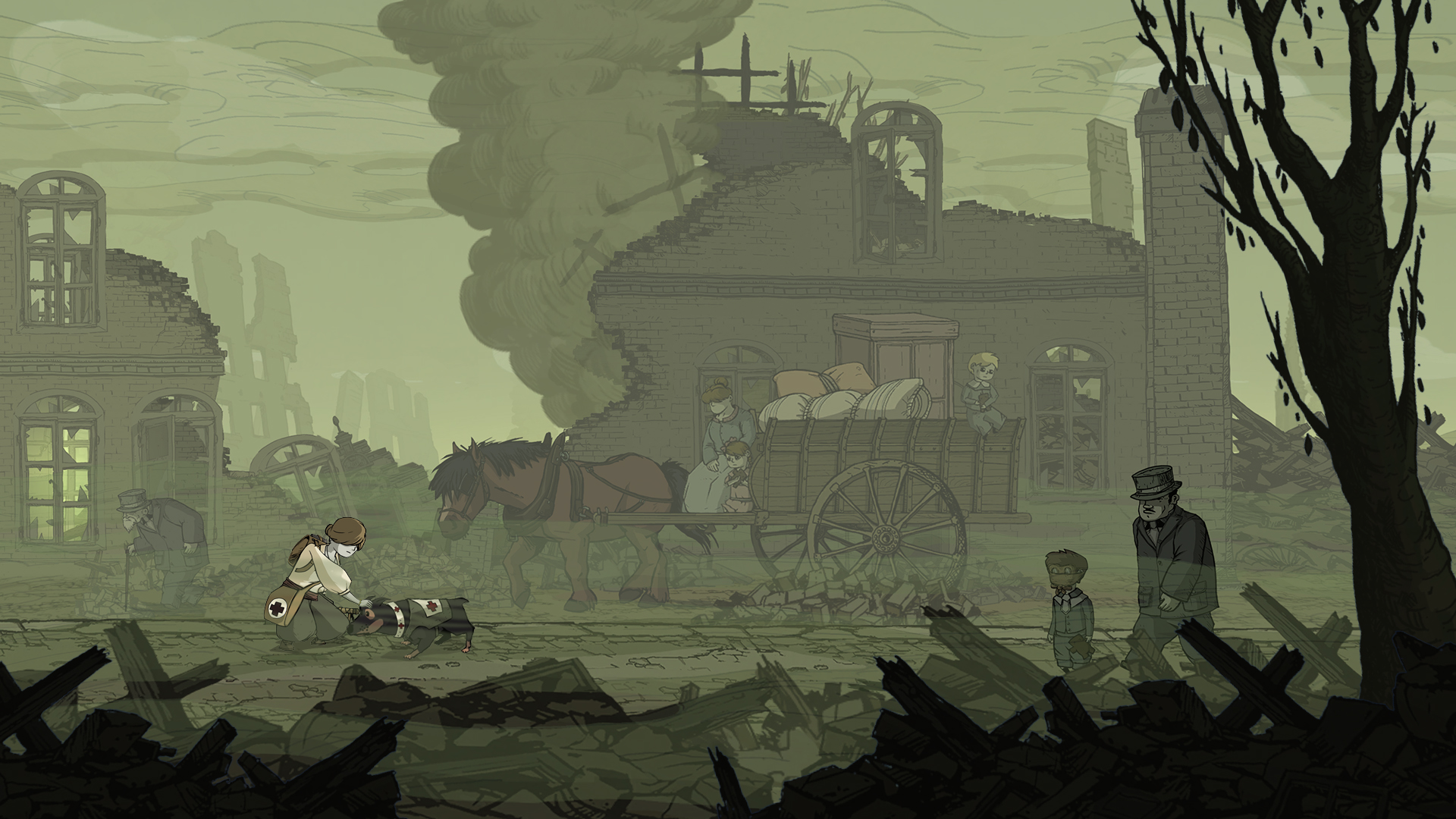
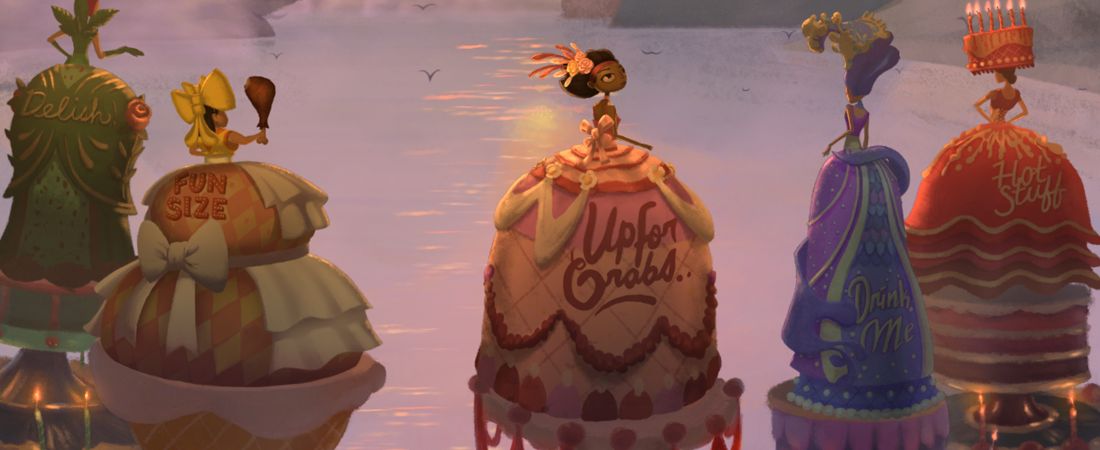
11 thoughts on “Quit Nomming My Neck! An Analytical Look at Unconventional Femaless in Vampires”
I’m sorry but I have to correct you on this one:
Eli (Let the Right One In)
Eli is a male. They don’t really explain that in the movie though it is barely implied. The book goes further into detail that it was a boy who was castrated by the vampire that changed him into…well a vampire.
In the movie, he only hints that he’s male but never completely says it.
Just to add to that, ripping this from the wikipedia page:
While all three works portray the character as a 200–300 year-old vampire in the body of a child, the novel details the origin of this condition explicitly, revealing that Eli is in fact a male that was castrated by a vampire nobleman as part of the sadistic ritual that turned him into a vampire. This detail is omitted entirely from both film adaptations, but is referenced in a brief scene showing Eli’s scarred genitalia in the 2008 film. The original film ultimately leaves the character’s gender ambiguous, as the scene showing Eli’s scarred genitalia is not explained. Eli repeatedly tells Oskar “I’m not a girl”
I realized I skipped the end of your explanation. Please ignore me <_<;
Yes, that’s actually cited in Barry’s piece above, wherein she also specifies that she analyzes Eli as female because Eli presents as female, adopting a created female identity. Eli’s biological gender, and the history of how it was altered, isn’t the main issue on the table — Eli’s identity is what matters, and the agency required to create a whole self.
Yeaaah, I read most of the article then got too caught up in my correction before I got to the part where he explained it. I’m feeling a bit dumb at the moment.
No big deal! I figured you just saw the name and thought BUT WAIT!
I understand the layers you’re peeling back here to look at Rayne as a positive symbol of female power in that she’s unconventional and serves as an opposing figure to traditional femaleness. But I think it’s a hard sell: how is Rayne not the trope of the femme fatale? Isn’t the femme fatale ultimately born of a male sex fantasy. She’s the woman that will have sex with men and because she’s evil he doesn’t have to even think of bringing her home to mom. It’s a have your cake and eat it too proposition, women being both virginal but also sexual. True, Rayne is being presented as *chosing* this identity, but I’m not sure that can be separated from the fact that her developers are male. Though, I can see how even a male designer’s own fantasies of independent women could produce Rayne, what he creates is ultimately a reproduction of existing tropes here. This is a game with jiggle-physics on breasts and where the women dress in the kinds of clothes found in torture porn.
On the one hand I understand where you’re coming from and agree with your ideas. On the other, Rayne doesn’t seem to fit the bill.
Hi Doone,
Thank you for your response! I appreciate it.
I struggled with Rayne as an example because, like you said, she fits the trope of the femme fatale. It was hard for me to distance myself from the hypersexualization (jiggle-physics on breasts, her dominatrix-esque outfit, and so on ). The hypersexualization is very loud and apparent. I tried to put on a different lens and examine Rayne in terms of how she opposes traditional femininity but sometimes the lens would crack or splinter. I had several lengthy discussions with Alisha about how I should go about it because I had such a difficult time with Rayne as an example.
Can you think of any other vampire characters that might better fit this lens?
Sorry for the late reply. I’m a full time everything so I don’t get to check my blogs as much as I want lately. Also, i want to make clear I don’t think the lens is bad here. I think it’s a really feminist take on Rayne because in a *fantasy* Rayne is most certainly her own woman. If we read her as you do, then as a character she’s made her own decisions — and if sexy monster slaying is her choice, then I applaud it. It’s a fascinating examination for sure and as a male it can be challenging to identify my own flawed lenses.
In video games, I can’t really think of any good examples and the closest that comes to mind is is Karen from Blade (http://www.imdb.com/media/rm3910252544/ch0282451). She’s a dated model in that I think today’s heroines are able to really defy cultural norms, bring their own sexy, in a way that’s generally acceptable to the public. In 1998, we were coming of age, but not quite there. Still, I think she’s a strong female vampire slayer, sexy but not sexualized, strong, all of the above. I can’t think of a single video game that gets this right. Sounds like a good opportunity, heh.
I’m going to do some more homework on woman vampires slayers in games and maybe I’ll write about my findings.
Sorry for the late reply. I’m a full time everything so I don’t get to check my blogs as much as I want lately. Also, i want to make clear I don’t think the lens is bad here. I think it’s a really feminist take on Rayne because in a *fantasy* Rayne is most certainly her own woman. If we read her as you do, then as a character she’s made her own decisions — and if sexy monster slaying is her choice, then I applaud it. It’s a fascinating examination for sure and as a male it can be challenging to identify my own flawed lenses.
In video games, I can’t really think of any good examples and the closest that comes to mind is is Karen from Blade (http://www.imdb.com/media/rm3910252544/ch0282451). She’s a dated model in that I think today’s heroines are able to really defy cultural norms, bring their own sexy, in a way that’s generally acceptable to the public. In 1998, we were coming of age, but not quite there. Still, I think she’s a strong female vampire slayer, sexy but not sexualized, strong, all of the above. I can’t think of a single video game that gets this right. Sounds like a good opportunity, heh.
I’m going to do some more homework on woman vampires slayers in games and maybe I’ll write about my findings.